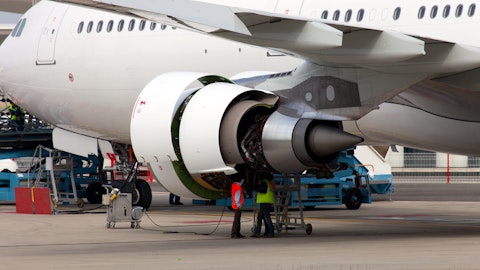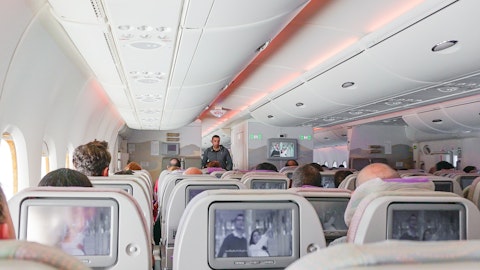Copa Holdings, S.A. (NYSE:CPA) Q3 2023 Earnings Call Transcript November 16, 2023
Operator: Ladies and gentlemen, thank you for standing by. Welcome to Copa Holdings Third Quarter Earnings Call. [Operator Instructions] As a reminder, this call — this webcast is being recorded on November 16, 2023. Now, I will turn the conference call over to Daniel Tapia, Director of Investor Relations. Sir, you may begin.
Daniel Tapia: Thank you, Avy [ph] and welcome, everyone, to our third quarter earnings call. Joining us today are Pedro Heilbron, CEO of Copa Holdings; and Jose Montero, our CFO. First, Pedro will start by going over our third quarter highlights, followed by Jose, who will discuss our financial results. Immediately after, we will open the call for questions from analysts. Copa Holdings financial reports have been prepared in accordance with International Financial Reporting Standards. In today’s call, we will discuss non-IFRS financial measures. A reconciliation of the non-IFRS to IFRS financial measures can be found in our earnings release which has been posted on the company’s website, copaair.com. Our discussion today will also contain forward-looking statements, not limited to historical facts that reflect the company’s current beliefs, expectations and/or intentions regarding future events and results.
These forward-looking statements involve risks and uncertainties that could cause actual results to differ materially and are based on assumptions subject to change. Many of these are discussed in our annual report filed with the SEC. Now, I’d like to turn the call over to our CEO, Mr. Pedro Heilbron.
Pedro Heilbron: Thank you, Daniel. Good morning to all and thanks for participating in our third quarter earnings call. Before we begin, I would like to extend my sincere gratitude to all our coworkers for their commitment to the company. Their continuous efforts and dedication have kept Copa at the forefront of Latin American aviation. To them, as always, my highest regards and admiration. As you can see in our third quarter earnings release, once again, Copa reported strong financial results for the quarter. We were able to deliver industry-leading operating margins while continuing to grow our capacity by double digits year-over-year. The third quarter results were driven by a robust demand environment in the region and our focus on delivering low ex-fuel unit costs.
Now, I’ll summarize the main highlights for Q3. Passenger traffic grew 13.3% compared to the same period in ’22, outpacing our capacity growth of 12.1%. As a result, load factor for the quarter increased 0.9 percentage points compared to Q3 ’22 to 87.8%. Passenger yield came in at $0.134 resulting in unit revenues or RASM of $0.122. Unit costs decreased by 11.2% compared to Q3 ’22, mainly driven by a lower jet fuel price per gallon and lower sales and distribution costs. Excluding fuel, unit costs or CASM-Ex came in at $0.058, a 2% decrease compared to Q3 ’22. And our operating margin came in at 23.6%, 5.9 percentage points higher than in the third quarter of ’22. On the operational front, Copa Airlines delivered an on-time performance of 89.4% and a completion factor of 99.8%, once again among the best in the world.
With regards to our network, in the last 2 quarters, we have started service to Austin and Baltimore in the U.S. and Manta, Ecuador. And more recently, in October, we started flying to Barquisimeto in Venezuela. With these additions, we now serve 81 destinations in 32 countries in North, Central, South America and the Caribbean. As we continue strengthening and solidifying our position as the most complete and convenient connecting hub in Latin America. With regards to our fleet; during the third quarter, we took delivery of two 737 MAX 9 ending the quarter with a total of 103 aircraft. Turning now to Wingo; in the third quarter, Wingo continued its network expansion with the start of 3 new routes from Bogota to Caracas, Venezuela; a Panama domestic flight from Panama City to David and one seasonal route from Cali to Aruba.
Additionally, in October, Wingo started service from Medellin to Cartagena and announced one additional domestic route in December from Medellin to Santa Marta. With these additions, Wingo expects to end the year operating 37 routes with service to 23 cities in 11 countries. Now, turning to our current expectations. We continue to see a robust demand environment in the region. And as you can see in our earnings release published yesterday, we expect strong financial results for full year ’23 and preliminary in 2024, we plan to continue growing our capacity in the low double-digit range and further reduce our unit costs. As always, Jose will provide more details regarding the 2023 and 2024 outlook. To summarize, we delivered strong third quarter results while growing capacity 12% year-over-year.
We continue to see a robust demand environment in the region. We achieved low fuel unit costs during the quarter and we continue to deliver on our cost execution strategies. We continue growing and strengthening our network, the most complete and convenient hub for travel in the Americas. And as always, our team continues to deliver world-leading operational results. Lastly, we remain as confident as ever in our business model. We continue to deliver low unit cost, high margins and a great product for our passengers, including the best connecting network in Latin America making us the best positioned airline in our region to consistently deliver industry-leading results. Now, I’ll turn it over to Jose, who will go over our financial results in more detail.

Jose Montero: Thank you, Pedro. Good morning, everyone. Thanks for being with us today. I’d like to join Pedro in acknowledging our great team for all their efforts to deliver world-class service to our passengers. I will start by going over our third quarter results. We reported a net profit for the quarter of $187.4 million or $4.72 per share. Excluding special items, our adjusted net profit came in at $174.4 million or $4.39 per share. Third quarter special items are comprised of a net gain of $12.2 million related to the company’s convertible notes which we retired during the quarter and an $800,000 unrealized mark-to-market gain related to changes in the value of financial investments. We reported a quarterly operating profit of $205 million and an operating margin of 23.6%.
Capacity came in at 7.1 billion available seat miles or 12.1% higher than in Q3 2022. Our load factor came in at 87.8% for the quarter, a 0.9 percentage point increase compared to the same period in 2022, while we achieved passenger yields of $0.134. As a result, unit revenues came in at $0.122, mainly driven by lower jet fuel prices, unit cost or CASM decreased to $0.093 or 11.2% lower than our CASM in Q3 2022. And finally, we continue with our initiatives for maintaining our costs low. For the quarter, our CASM ex-fuel came in at $0.058, a 2.1% decrease versus Q3 2022, mainly driven by lower sales and distribution costs due to the higher penetration of both direct sales and the lower cost travel agency channels which were launched by Copa Airlines in September of 2022.
I’m going to spend some time now discussing our balance sheet and liquidity. As of the end of the third quarter, we had assets of close to $5 billion. As to cash, short- and long-term investments, we ended the quarter with over $1.2 billion which represents 34% of our last 12 months’ revenues. And in terms of debt, we ended the quarter with $1.7 billion in debt and lease liabilities and came in with an adjusted net debt-to-EBITDA ratio of 0.4x. Our debt now is comprised solely of aircraft-related debt and I’m pleased to report that our average cost of debt is currently in the range of 3.4%. As we’ve previously announced, in the month of September, we completed with the redemption of the 4.5% convertible senior notes due in 2025. To summarize the transaction, holders of $349 million aggregate principal amount converted their notes in accordance with the terms of the inventory while holders of outstanding notes in the aggregate principal amount of $1 million redeemed at a price equal to 100% of the principal amount of each note call [indiscernible].
This was paid in cash plus accrued and unpaid interest. As a result, the transaction generated a total cash payment of $350 million in addition to approximately 3.7 million shares. Turning now to our fleet; during the third quarter, we received 2 Boeing 737 MAX 9s to end the quarter with a total of 103 aircraft. In November, we received 2 additional 737 MAX 9s to bring our total fleet to 105 aircraft. With these additions, our total fleet is now comprised of 68 737-800s, 28 737 MAX 9s and 9 737-700s. These figures include one 737-800 freighter and the 9 737-800s operated by Wingo. 2/3 of our fleet continues to be comprised of owned aircraft and 1/3 of our aircraft are under operating leases. During the remainder of 2023, we expect to receive one additional aircraft of Boeing 737 MAX 9 to end the year with a total fleet of 106 aircraft.
As for our 2024 fleet plan, preliminarily, next year, we expect to receive 15%, 7% of MAX aircraft, including 3 737 MAX 9s and 12 737 MAX 8s. We’ve published an updated fleet plan of our — in our Investor Relations website and we have already secured JOLCO financing for 10 out of the 15 deliveries in 2024. Turning now to a return of value to our shareholders. In October, we finalized the execution of our existing share repurchase program. And as published in our earnings release yesterday, our Board of Directors approved a new share repurchase program of $200 million. Additionally, I’m pleased to announce that our Board has ratified the fourth dividend payment of the year of $0.82 per share to be paid on December 15 to all shareholders of record as of November 30th.
As to our outlook, we can provide the following guidance update for full year 2023. We expect to increase our capacity in ASMs versus 2022 by approximately 13% and we expect to deliver an operating margin within the range of 23%. We’re basing our outlook on the following assumptions: load factor of approximately 87%, unit revenues within the range of $0.124, CASM ex-fuel to be in the range of $0.06 and we are expecting an all-in fuel price of $3.02 per gallon. In anticipation of 2024, we are projecting a year-over-year capacity increase between 12% and 14%. Additionally, we anticipate our CASM ex-fuel to be in the range of $0.059, aligning with our goal to achieve a CASM ex-fuel of $0.058 by 2025. This outlook reflects our continuous commitment to our operational excellence.
Thank you. And with that, we’ll open the call for some questions.
Operator: [Operator Instructions] Our first question comes from Savi Syth with Raymond James.
See also Jim Cramer Recommends Selling These 10 Stocks and 12 Best Debt Free Stocks To Buy.
Q&A Session
Follow Copa Holdings Sa (NYSE:CPA)
Follow Copa Holdings Sa (NYSE:CPA)
Savi Syth: If I might ask on the revenue front, you took kind of the outlook up here for 2023. And it doesn’t seem like the competitive capacity, you’ve seen any pullback since your last update and I don’t think your capacity has even kind of come down and — just curious what you’re seeing in the market that’s driving that strength? And just any color on if there is any kind of regional differences and how you see that continuing?
Pedro Heilbron: Savi, it’s Pedro. Demand is staying strong in spite of the additional capacity that’s coming in from ourselves and especially from other airlines. I don’t think there’s specific reason for that. I mean the currencies have stayed strong also in Latin America. So that doesn’t hurt. And the U.S. economy is doing well also. So I think all those factors are contributing for demand to remain robust in spite of the capacity.
Jose Montero: I would say, Savi, only that in general terms and this applies throughout the network and all the different regions that we’re at. In general, still very robust.
Savi Syth: That’s helpful. And if I might ask on the — after the convert is done and the share buybacks that you’ve done so far, where does the share count stand today?
Jose Montero: We’re at 42 million shares — around 42 million shares right now, Savi.
Operator: Our next question comes from Duane Pfennigwerth with Evercore ISI.
Unidentified Analyst: This is Jake [ph] on for Duane. First question, on non-op. Is that the new run rate for non-op? Or were there any onetime benefits this quarter? And then could you just remind us what the actual interest expense through the P&L was given that it was different from what the coupon rate would indicate from the convert?
Jose Montero: Yes, Jake, I would summarize that taking aside the effect of the convert that we retired and going forward, I would say that our finance cost line would probably go down by approximately $10 million per quarter. So I would say that’s the way to model it. The remainder of the non-op lines in general terms are in line with just simply the debt levels that we have and the average cost of debt that I mentioned that is about 3.4% right now and the yields that we have in terms of our investments. I would say that’s — the big change going forward, I would say, is the reduction in the finance cost line not associated with the coupon but rather associated with the way the accounting for the convert work, it was like a noncash item that passed through the P&L and it was around $10 million per quarter.
Unidentified Analyst: Right. That makes sense. And then just to go a little bit deeper into 2024 capacity growth. Could you just break out the components and the pacing of that seat, stage length, gauge, et cetera?
Jose Montero: I would say, Jake, that the majority of the growth for next year is going to be frequencies. Here we have it broken down is about, call it, about 70% of the capacity growth is going to be in additional frequencies into markets that we operate already. Then about, let’s say, about 25% is going to be around full year effect of growth that we performed throughout 2023, that sort of lapse the year. And then the remainder is, call it, a new service that we’re starting in 2024. That’s kind of how we’re placing it. So the vast majority is just frequencies into markets that we’re really present in.
Unidentified Analyst: And so with the patient of that be steady here?
Jose Montero: In general terms, throughout a year, you say, a cadence. A little bit of a — yes, I would say, in general terms, steady. I don’t think there is a particular bumps throughout the year, given the majority of it is — or a portion of it is full year effect.
Pedro Heilbron: Our aircraft deliveries in any case are spread throughout the year. So that’s another reason.
Operator: Our next question comes from Guilherme Mendes with JPMorgan.
Guilherme Mendes: Two questions as well. The first one is on the fleet plan. You guys mentioned about 15 deliveries next year on MAXs. If you see any kind of bottlenecks come from Boeing or any risk on this 15 aircraft deliveries? I understand that you mentioned that 10% are really secure in terms of financing. So if there’s any kind of risk for this additional five? So the second question is regarding to the CASM ex-fuel guidance for next year, cutting price to see lower CASM ex-fuel? And maybe if you could comment on what are the main initiatives thinking that there’s any kind of labor pressure, any out of initiatives to sustain this higher efficiency?
Pedro Heilbron: Yes. So a few things. In terms of the aircraft deliveries, 11 of the 15 deliveries scheduled for next year are already financed with JOLCO. So that’s pretty much said. And in terms of delivery dates, this is the latest we have from Boeing, some aircraft passed from one aircraft at least passes from 2023 to 2024. That’s why the number increased to 15%. So it’s the best information we have right now. And again, most of the financing is already in place.
Jose Montero: Yes. But they’re — I mean, we’re still unsure Boeing; all aircraft manufacturers are facing supply chain issues. So we have our conversation going with them. But I — for now, in our — in terms of our guidance, I have to start by saying that it’s a preliminary guidance that we issued for a year. We’ll issue our formal guidance in February but in general terms, it’s in line with our expectations in terms of aircraft deliveries for 2024. And in terms of CASM for next year, I would say that the main areas of opportunities, first of all, is our continue working our distribution. Our team has been doing a great job there with the Copa Connect project and our new distribution strategy. Number two, we are continuing with our fleet densification of our 737-800 fleet on the Copa Airlines side.





